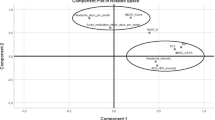Abstract
The 6-item Headache Impact Test questionnaire (HIT-6) is a simple and reliable tool to measure the impact headaches have on patients’ lives. Patients with chronic migraine (CM) and medication overuse are markedly impaired in their functional activity. The aim of this study was to investigate the responsiveness of the HIT-6 tool to clinical changes induced by treatment in patients with CM and medication overuse. A sample of 160 patients underwent a day-hospital withdrawal treatment followed by prophylaxis. Sixty-two of them completed the 12-month follow up. Patients improved significantly after treatment intervention, as days of headache per month and medications/month decreased from baseline to follow up. Also HIT-6 scores improved, with mean score decreasing from 65±5.4 (median 65) to 59.4±8.5 (median 62) (Student’s t-test p<0.00001) and with a reduction in the percentage of patients with very severe headache-related impact one year after withdrawal therapy.
Similar content being viewed by others
References
Lipton RB, Hamelsky S, Kolodner KB et al (2000) Migraine, quality of life and depression: a population based case-control study. Neurology 55:629–635
Terwindt G, Ferrari M, Tihuis M et al (2000) The impact of migraine on quality of life in the general population: the GEM study. Neurology 55:624–629
Matchar DB, Young WB, Rosenerg J et al and the US Headache Consortium (2000) Multispecialty consensus on diagnosis and treatment of headache: pharmacological management of acute attacks. www.aan.com/professionals/practice/pdfs/gl0087.pdf
Ramadan NM, Silberstein SD, Freitag FG et al and the US Headache Consortium. Evidence-based guidelines for migraine headache in the primary care setting: pharmacological management for prevention of migraine. www.aan.com/professionals/practice/pdfs/gl0090.pdf
Kosinski M, Bayliss MS, Bjorner JB et al (2003) A six-item short-form survey for measuring headache impact: the HIT-6. Qual Life Res 12:963–974
Kawata AK, Coeytaux RR, Devellis RF et al (2005) Psychometric properties of the HIT-6 among patients in a headache-specialty practice. Headache 45:638–643
De Diego EV, Lanteri-Minet M (2005) Recognition and management of migraine in primary care: influence of functional impact measured by the headache impact test (HIT). Cephalalgia 25:184–190
Coeytaux RR, Linville JC (2007) Chronic daily headache in a primary care population: prevalence and headache impact test scores. Headache 47:7–12
Monzon MJ, Lainez MJ (1998) Quality of life in migraine and chronic daily headache patients. Cephalalgia 18:638–643
Meletiche DM, Lofland JH, Young WB (2001) Quality-of life differences between patients with episodic and transformed migraine. Headache 41:573–578
Wang SJ, Fuh JL, Lu SR, Juang KD (2001) Quality of life differs among headache diagnoses: analysis of SF-36 survey in 901 headache patients. Pain 89:285–292
Guitera V, Munoz P, Castillo J, Pascual J (2002) Quality of life in chronic daily headache: a study in a general population. Neurology 58:1062–1065
Magnusson JE, Becker WJ (2002) A comparison of disability and psychological factors in migraine and transformed migraine. Cephalalgia 22:172–178
Bigal ME, Rapoport AM, Lipton RB et al (2003) Assessment of migraine disability using the migraine disability assessment (MIDAS) questionnaire: a comparison of chronic migraine with episodic migraine. Headache 43:336–342
D’Amico D, Grazzi L, Usai S et al (2005) Disability pattern in chronic migraine with medication overuse: a comparison with migraine without aura. Headache 45:553–560
Silberstein SD, Lipton RB (2000) Chronic daily headache. Curr Opin Neurol 13:277–283
Author information
Authors and Affiliations
Corresponding author
Rights and permissions
About this article
Cite this article
Usai, S., Grazzi, L., D’Amico, D. et al. Reduction in the impact of chronic migraine with medication overuse after day-hospital withdrawal therapy. Neurol Sci 29 (Suppl 1), 176–178 (2008). https://doi.org/10.1007/s10072-008-0918-1
Published:
Issue Date:
DOI: https://doi.org/10.1007/s10072-008-0918-1




